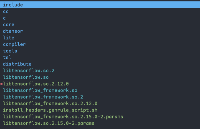译者注
笔者在MacBook M2上搭建Linux虚拟机上开发eBPF程序时,遇到一些LSM eBPF类型程序无法运行的问题,哪怕是5.15内核的ubuntu server,依旧无法正常运行。显然,aarch64跟x86_64的内核功能有差异。在笔者尝试定位这些差异时,看到这篇文章,可以让大家更直观地了解LSM eBPF在两种CPU 内核上的差异。
原文本博客文章是我们在Linux中对于`aarch64`上`BPF LSM`支持的内部研究的摘要。如果你对内核代码库不熟悉,要开始查看内核源码是非常困难的,因此我们决定发布这篇文章,展示我们的方法,因为这对于想要探索内核内部的任何人都可能有所帮助。
简介
在x86_64上,我们已经在使用BPF LSM,而在aarch64上,我们依赖于Kprobes,因此我们想知道内核中缺少了哪些功能,才能让这些功能在aarch64上可用。
我们曾多次深入研究内核源代码,但通常我们搜索的是已经存在的东西,以了解其工作原理。但在这种情况下,我们在寻找的是不存在的东西,我们追寻的是那些因为未实现而返回错误的内容。
回想起Steven Rostedt关于如何开始学习Linux内核的讲话,我们从ftrace(以及构建在跟踪基础设施上的工具)开始,以了解当我们将一个不受支持的BPF程序加载到内核时会发生什么。
问题
这是当我们尝试将一个BPF LSM程序加载到aarch64 5.15 Linux内核时,使用我们的软件pulsar[2]时的输出:
root@pine64-1:/home/exein#./pulsar-enterprise-execpulsard [2023-02-16T1445ZINFOpulsar::daemon]Startingmoduleprocess-monitor [2023-02-16T1445ZINFOpulsar::daemon]Startingmodulefile-system-monitor [2023-02-16T1446ZINFOpulsar::daemon]Startingmodulenetwork-monitor [2023-02-16T1446ZINFOpulsar::daemon]Startingmodulelogger [2023-02-16T1446ZINFOpulsar::daemon]Startingmodulerules-engine [2023-02-16T1446ZINFOpulsar::daemon]Startingmoduledesktop-notifier [2023-02-16T1446ZERRORpulsar::module_manager]Moduleerrorinfile-system-monitor:failedprogramattachlsmpath_mknod Causedby: 0:`bpf_raw_tracepoint_open`failed 1:Noerrorinformation(oserror524) [2023-02-16T1446ZINFOpulsar::daemon]Startingmoduleanomaly-detection [2023-02-16T1446ZINFOpulsar::daemon]Startingmodulemalware-detection [2023-02-16T1446ZERRORpulsar::module_manager]Moduleerrorinmalware-detection:/var/lib/pulsar/malware_detection/models/parameters.jsonnotfound [2023-02-16T1446ZINFOpulsar::daemon]Startingmoduleplatform-connector [2023-02-16T1446ZINFOplatform_connector::client]Connectedtohttps://platform-dev-instance.exein.io:8001/ [2023-02-16T1446ZINFOpulsar::daemon]Startingmodulethreat-response [2023-02-16T1446ZERRORpulsar::module_manager]Moduleerrorinnetwork-monitor:failedprogramattachlsmsocket_bind Causedby: 0:`bpf_raw_tracepoint_open`failed 1:Noerrorinformation(oserror524)
我们在尝试加载与path_mknodLSM挂钩相关的BPF程序时,pulsar出现了错误524或ENOTSUPP。让我们尝试深入研究这个问题。
注意: 在进行这项研究时,我们当时无法找到预先编译为启用BPF和BTF的aarch64,因此我们不得不编译一个自定义内核。我们还启用了跟踪选项和function_graph插件,以使用下面的工具。
所有的实验都是在一台装有定制Armbian[3]镜像的Pine A64上进行的。
这些镜像具有带有标准Ubuntu 22.04 LTS Jammy用户空间的自定义内核。
工具
为了调查这个问题,我们使用了以下工具:
bpftrace[4]:基于BPF的工具,使用自定义类C语言动态附加探针。
trace-cmd[5]:围绕tracefs文件系统的包装器,与ftrace基础设施交互。
要使用这些工具,您需要在Linux内核中启用一些选项,请查阅官方文档获取完整的要求。
注意: 也可以使用其他工具来完成相同的工作,例如perf-tools[6]中的funcgraph和kprobe。
Linux 5.15
现在我们开始使用这些工具来查看在内核5.15中尝试加载我们的BPF程序时会发生什么。
从这一点开始到本文末尾,我们将使用probe二进制文件代替pulsar,因为它更简单。为了简要概括其工作原理,以下是命令行帮助:
exein@pine64-1:~$./probe TestrunnerforeBPFprograms Usage:probe[OPTIONS]Commands: file-system-monitorWatchfilecreations process-monitorWatchprocessevents(fork/exec/exit) network-monitorWatchnetworkevents helpPrintthismessageorthehelpofthegivensubcommand(s) Options: -v,--verbose -h,--helpPrinthelp -V,--versionPrintversion
在这些示例中,我们将尝试加载file-system-monitor探针。
通过运行以下命令,我们可以看到__sys_bpf函数的函数图调用,这是BPF系统调用的入口点:
trace-cmdrecord-pfunction_graph-g__sys_bpf./probefile-system-monitor trace-cmdreport
输出是一个非常庞大的函数图,太大了,无法在这里粘贴。由于我们遇到了错误,我们对程序停止前的最后几个函数感兴趣。以下是trace-cmd report输出的最后几行:
...
tokio-runtime-w-1666[003]1318.058019:funcgraph_entry:|bpf_trampoline_link_prog(){
tokio-runtime-w-1666[003]1318.058020:funcgraph_entry:2.292us|bpf_attach_type_to_tramp();
tokio-runtime-w-1666[003]1318.058024:funcgraph_entry:1.250us|mutex_lock();
tokio-runtime-w-1666[003]1318.058028:funcgraph_entry:|bpf_trampoline_update(){
tokio-runtime-w-1666[003]1318.058030:funcgraph_entry:|kmem_cache_alloc_trace(){
tokio-runtime-w-1666[003]1318.058031:funcgraph_entry:1.167us|should_failslab();
tokio-runtime-w-1666[003]1318.058036:funcgraph_exit:6.792us|}
tokio-runtime-w-1666[003]1318.058039:funcgraph_entry:|kmem_cache_alloc_trace(){
tokio-runtime-w-1666[003]1318.058042:funcgraph_entry:2.750us|should_failslab();
tokio-runtime-w-1666[003]1318.058046:funcgraph_exit:6.417us|}
tokio-runtime-w-1666[003]1318.058048:funcgraph_entry:2.708us|bpf_jit_charge_modmem();
tokio-runtime-w-1666[003]1318.058053:funcgraph_entry:|bpf_jit_alloc_exec_page(){
tokio-runtime-w-1666[003]1318.058055:funcgraph_entry:|bpf_jit_alloc_exec(){
tokio-runtime-w-1666[003]1318.058057:funcgraph_entry:|vmalloc(){
tokio-runtime-w-1666[003]1318.058059:funcgraph_entry:|__vmalloc_node(){
tokio-runtime-w-1666[003]1318.058061:funcgraph_entry:|__vmalloc_node_range(){
tokio-runtime-w-1666[003]1318.058064:funcgraph_entry:|__get_vm_area_node.constprop.64(){
tokio-runtime-w-1666[003]1318.058067:funcgraph_entry:|kmem_cache_alloc_node_trace(){
tokio-runtime-w-1666[003]1318.058069:funcgraph_entry:1.459us|should_failslab();
tokio-runtime-w-1666[003]1318.058073:funcgraph_exit:6.292us|}
tokio-runtime-w-1666[003]1318.058075:funcgraph_entry:|alloc_vmap_area(){
tokio-runtime-w-1666[003]1318.058077:funcgraph_entry:|kmem_cache_alloc_node(){
tokio-runtime-w-1666[003]1318.058079:funcgraph_entry:1.167us|should_failslab();
tokio-runtime-w-1666[003]1318.058085:funcgraph_exit:7.625us|}
tokio-runtime-w-1666[003]1318.058088:funcgraph_entry:|kmem_cache_alloc_node(){
tokio-runtime-w-1666[003]1318.058089:funcgraph_entry:1.208us|should_failslab();
tokio-runtime-w-1666[003]1318.058092:funcgraph_exit:4.584us|}
tokio-runtime-w-1666[003]1318.058104:funcgraph_entry:|kmem_cache_free(){
tokio-runtime-w-1666[003]1318.058107:funcgraph_entry:2.084us|__slab_free();
tokio-runtime-w-1666[003]1318.058110:funcgraph_exit:5.667us|}
tokio-runtime-w-1666[003]1318.058112:funcgraph_entry:6.375us|insert_vmap_area.constprop.74();
tokio-runtime-w-1666[003]1318.058119:funcgraph_exit:+44.667us|}
tokio-runtime-w-1666[003]1318.058122:funcgraph_exit:+58.250us|}
tokio-runtime-w-1666[003]1318.058124:funcgraph_entry:|__kmalloc_node(){
tokio-runtime-w-1666[003]1318.058125:funcgraph_entry:1.625us|kmalloc_slab();
tokio-runtime-w-1666[003]1318.058128:funcgraph_entry:1.167us|should_failslab();
tokio-runtime-w-1666[003]1318.058131:funcgraph_exit:7.208us|}
tokio-runtime-w-1666[003]1318.058133:funcgraph_entry:|alloc_pages(){
tokio-runtime-w-1666[003]1318.058135:funcgraph_entry:1.583us|get_task_policy.part.48();
tokio-runtime-w-1666[003]1318.058138:funcgraph_entry:1.500us|policy_node();
tokio-runtime-w-1666[003]1318.058141:funcgraph_entry:1.209us|policy_nodemask();
tokio-runtime-w-1666[003]1318.058143:funcgraph_entry:|__alloc_pages(){
tokio-runtime-w-1666[003]1318.058145:funcgraph_entry:1.458us|should_fail_alloc_page();
tokio-runtime-w-1666[003]1318.058147:funcgraph_entry:|get_page_from_freelist(){
tokio-runtime-w-1666[003]1318.058150:funcgraph_entry:1.583us|prep_new_page();
tokio-runtime-w-1666[003]1318.058153:funcgraph_exit:5.459us|}
tokio-runtime-w-1666[003]1318.058154:funcgraph_exit:+10.542us|}
tokio-runtime-w-1666[003]1318.058155:funcgraph_exit:+22.083us|}
tokio-runtime-w-1666[003]1318.058157:funcgraph_entry:|__cond_resched(){
tokio-runtime-w-1666[003]1318.058158:funcgraph_entry:1.833us|rcu_all_qs();
tokio-runtime-w-1666[003]1318.058161:funcgraph_exit:4.167us|}
tokio-runtime-w-1666[003]1318.058166:funcgraph_entry:5.542us|vmap_pages_range_noflush();
tokio-runtime-w-1666[003]1318.058173:funcgraph_exit:!112.375us|}
tokio-runtime-w-1666[003]1318.058175:funcgraph_exit:!116.000us|}
tokio-runtime-w-1666[003]1318.058176:funcgraph_exit:!119.292us|}
tokio-runtime-w-1666[003]1318.058177:funcgraph_exit:!122.542us|}
tokio-runtime-w-1666[003]1318.058179:funcgraph_entry:|find_vm_area(){
tokio-runtime-w-1666[003]1318.058180:funcgraph_entry:1.375us|find_vmap_area();
tokio-runtime-w-1666[003]1318.058183:funcgraph_exit:4.333us|}
tokio-runtime-w-1666[003]1318.058185:funcgraph_entry:|set_memory_x(){
tokio-runtime-w-1666[003]1318.058186:funcgraph_entry:|change_memory_common(){
tokio-runtime-w-1666[003]1318.058188:funcgraph_entry:|find_vm_area(){
tokio-runtime-w-1666[003]1318.058189:funcgraph_entry:1.333us|find_vmap_area();
tokio-runtime-w-1666[003]1318.058192:funcgraph_exit:3.875us|}
tokio-runtime-w-1666[003]1318.058193:funcgraph_entry:|vm_unmap_aliases(){
tokio-runtime-w-1666[003]1318.058194:funcgraph_entry:|_vm_unmap_aliases.part.58(){
tokio-runtime-w-1666[003]1318.058196:funcgraph_entry:1.542us|rcu_read_unlock_strict();
tokio-runtime-w-1666[003]1318.058199:funcgraph_entry:1.208us|rcu_read_unlock_strict();
tokio-runtime-w-1666[003]1318.058202:funcgraph_entry:1.166us|rcu_read_unlock_strict();
tokio-runtime-w-1666[003]1318.058205:funcgraph_entry:1.208us|rcu_read_unlock_strict();
tokio-runtime-w-1666[003]1318.058207:funcgraph_entry:1.208us|mutex_lock();
tokio-runtime-w-1666[003]1318.058210:funcgraph_entry:|purge_fragmented_blocks_allcpus(){
tokio-runtime-w-1666[003]1318.058212:funcgraph_entry:1.500us|rcu_read_unlock_strict();
tokio-runtime-w-1666[003]1318.058214:funcgraph_entry:1.500us|rcu_read_unlock_strict();
tokio-runtime-w-1666[003]1318.058217:funcgraph_entry:1.500us|rcu_read_unlock_strict();
tokio-runtime-w-1666[003]1318.058220:funcgraph_entry:1.167us|rcu_read_unlock_strict();
tokio-runtime-w-1666[003]1318.058222:funcgraph_exit:+11.917us|}
tokio-runtime-w-1666[003]1318.058224:funcgraph_entry:|__purge_vmap_area_lazy(){
tokio-runtime-w-1666[003]1318.058232:funcgraph_entry:|kmem_cache_free(){
tokio-runtime-w-1666[003]1318.058234:funcgraph_entry:1.250us|__slab_free();
tokio-runtime-w-1666[003]1318.058237:funcgraph_exit:4.791us|}
tokio-runtime-w-1666[003]1318.058241:funcgraph_entry:1.209us|__cond_resched_lock();
tokio-runtime-w-1666[003]1318.058244:funcgraph_exit:+19.625us|}
tokio-runtime-w-1666[003]1318.058245:funcgraph_entry:1.167us|mutex_unlock();
tokio-runtime-w-1666[003]1318.058247:funcgraph_exit:+53.042us|}
tokio-runtime-w-1666[003]1318.058248:funcgraph_exit:+55.625us|}
tokio-runtime-w-1666[003]1318.058250:funcgraph_entry:|__change_memory_common(){
tokio-runtime-w-1666[003]1318.058251:funcgraph_entry:|apply_to_page_range(){
tokio-runtime-w-1666[003]1318.058253:funcgraph_entry:|__apply_to_page_range(){
tokio-runtime-w-1666[003]1318.058255:funcgraph_entry:1.250us|pud_huge();
tokio-runtime-w-1666[003]1318.058258:funcgraph_entry:1.166us|pmd_huge();
tokio-runtime-w-1666[003]1318.058260:funcgraph_entry:1.208us|change_page_range();
tokio-runtime-w-1666[003]1318.058263:funcgraph_exit:9.834us|}
tokio-runtime-w-1666[003]1318.058264:funcgraph_exit:+12.709us|}
tokio-runtime-w-1666[003]1318.058266:funcgraph_exit:+15.459us|}
tokio-runtime-w-1666[003]1318.058268:funcgraph_exit:+80.791us|}
tokio-runtime-w-1666[003]1318.058270:funcgraph_exit:+84.834us|}
tokio-runtime-w-1666[003]1318.058272:funcgraph_exit:!218.500us|}
tokio-runtime-w-1666[003]1318.058274:funcgraph_entry:|__alloc_percpu_gfp(){
tokio-runtime-w-1666[003]1318.058276:funcgraph_entry:|pcpu_alloc(){
tokio-runtime-w-1666[003]1318.058281:funcgraph_entry:2.250us|mutex_lock_killable();
tokio-runtime-w-1666[003]1318.058290:funcgraph_entry:|pcpu_find_block_fit(){
tokio-runtime-w-1666[003]1318.058293:funcgraph_entry:2.833us|pcpu_next_fit_region.constprop.38();
tokio-runtime-w-1666[003]1318.058299:funcgraph_exit:9.084us|}
tokio-runtime-w-1666[003]1318.058301:funcgraph_entry:|pcpu_alloc_area(){
tokio-runtime-w-1666[003]1318.058315:funcgraph_entry:4.000us|pcpu_block_update_hint_alloc();
tokio-runtime-w-1666[003]1318.058320:funcgraph_entry:2.208us|pcpu_chunk_relocate();
tokio-runtime-w-1666[003]1318.058324:funcgraph_exit:+22.625us|}
tokio-runtime-w-1666[003]1318.058327:funcgraph_entry:1.208us|mutex_unlock();
tokio-runtime-w-1666[003]1318.058332:funcgraph_entry:1.584us|pcpu_memcg_post_alloc_hook();
tokio-runtime-w-1666[003]1318.058335:funcgraph_exit:+58.833us|}
tokio-runtime-w-1666[003]1318.058336:funcgraph_exit:+61.834us|}
tokio-runtime-w-1666[003]1318.058338:funcgraph_entry:|kmem_cache_alloc_trace(){
tokio-runtime-w-1666[003]1318.058339:funcgraph_entry:1.167us|should_failslab();
tokio-runtime-w-1666[003]1318.058342:funcgraph_exit:4.458us|}
tokio-runtime-w-1666[003]1318.058359:funcgraph_entry:|bpf_image_ksym_add(){
tokio-runtime-w-1666[003]1318.058360:funcgraph_entry:|bpf_ksym_add(){
tokio-runtime-w-1666[003]1318.058363:funcgraph_entry:1.583us|__local_bh_enable_ip();
tokio-runtime-w-1666[003]1318.058366:funcgraph_exit:5.750us|}
tokio-runtime-w-1666[003]1318.058369:funcgraph_exit:9.834us|}
tokio-runtime-w-1666[003]1318.058371:funcgraph_entry:1.250us|arch_prepare_bpf_trampoline();
tokio-runtime-w-1666[003]1318.058373:funcgraph_entry:2.292us|kfree();
tokio-runtime-w-1666[003]1318.058377:funcgraph_exit:!348.625us|}
tokio-runtime-w-1666[003]1318.058379:funcgraph_entry:1.250us|mutex_unlock();
tokio-runtime-w-1666[003]1318.058382:funcgraph_exit:!363.167us|}
tokio-runtime-w-1666[003]1318.058384:funcgraph_entry:|bpf_link_cleanup(){
tokio-runtime-w-1666[003]1318.058386:funcgraph_entry:|bpf_link_free_id.part.30(){
tokio-runtime-w-1666[003]1318.058392:funcgraph_entry:|call_rcu(){
tokio-runtime-w-1666[003]1318.058396:funcgraph_entry:1.834us|rcu_segcblist_enqueue();
tokio-runtime-w-1666[003]1318.058401:funcgraph_exit:9.333us|}
tokio-runtime-w-1666[003]1318.058403:funcgraph_entry:1.542us|__local_bh_enable_ip();
tokio-runtime-w-1666[003]1318.058406:funcgraph_exit:+19.542us|}
tokio-runtime-w-1666[003]1318.058408:funcgraph_entry:|fput(){
tokio-runtime-w-1666[003]1318.058409:funcgraph_entry:|fput_many(){
tokio-runtime-w-1666[003]1318.058411:funcgraph_entry:|task_work_add(){
tokio-runtime-w-1666[003]1318.058414:funcgraph_entry:1.625us|kick_process();
tokio-runtime-w-1666[003]1318.058418:funcgraph_exit:6.750us|}
tokio-runtime-w-1666[003]1318.058419:funcgraph_exit:+10.333us|}
tokio-runtime-w-1666[003]1318.058420:funcgraph_exit:+12.708us|}
tokio-runtime-w-1666[003]1318.058422:funcgraph_entry:2.250us|put_unused_fd();
tokio-runtime-w-1666[003]1318.058426:funcgraph_exit:+41.416us|}
tokio-runtime-w-1666[003]1318.058428:funcgraph_entry:1.292us|mutex_unlock();
tokio-runtime-w-1666[003]1318.058430:funcgraph_entry:1.250us|kfree();
tokio-runtime-w-1666[003]1318.058433:funcgraph_exit:!567.458us|}
tokio-runtime-w-1666[003]1318.058435:funcgraph_entry:2.125us|__bpf_prog_put.isra.47();
tokio-runtime-w-1666[003]1318.058438:funcgraph_exit:!602.291us|}
tokio-runtime-w-1666[003]1318.058439:funcgraph_exit:!631.791us|}
```shell
这是`kernel/bpf/trampoline.c`中与最后执行的函数`bpf_trampoline_update`对应的源代码:
```c
staticintbpf_trampoline_update(structbpf_trampoline*tr)
{
structbpf_tramp_image*im;
structbpf_tramp_progs*tprogs;
u32flags=BPF_TRAMP_F_RESTORE_REGS;
boolip_arg=false;
interr,total;
tprogs=bpf_trampoline_get_progs(tr,&total,&ip_arg);
if(IS_ERR(tprogs))
returnPTR_ERR(tprogs);
if(total==0){
err=unregister_fentry(tr,tr->cur_image->image);
bpf_tramp_image_put(tr->cur_image);
tr->cur_image=NULL;
tr->selector=0;
gotoout;
}
im=bpf_tramp_image_alloc(tr->key,tr->selector);
if(IS_ERR(im)){
err=PTR_ERR(im);
gotoout;
}
if(tprogs[BPF_TRAMP_FEXIT].nr_progs||
tprogs[BPF_TRAMP_MODIFY_RETURN].nr_progs)
flags=BPF_TRAMP_F_CALL_ORIG|BPF_TRAMP_F_SKIP_FRAME;
if(ip_arg)
flags|=BPF_TRAMP_F_IP_ARG;
err=arch_prepare_bpf_trampoline(im,im->image,im->image+PAGE_SIZE,
&tr->func.model,flags,tprogs,
tr->func.addr);
if(err< 0)
goto out;
WARN_ON(tr->cur_image&&tr->selector==0);
WARN_ON(!tr->cur_image&&tr->selector);
if(tr->cur_image)
/*progsalreadyrunningatthisaddress*/
err=modify_fentry(tr,tr->cur_image->image,im->image);
else
/*firsttimeregistering*/
err=register_fentry(tr,im->image);
if(err)
gotoout;
if(tr->cur_image)
bpf_tramp_image_put(tr->cur_image);
tr->cur_image=im;
tr->selector++;
out:
kfree(tprogs);
returnerr;
}
根据先前的输出,我们可以看到:
tokio-runtime-w-1666[003]1318.058371:funcgraph_entry:1.250us|arch_prepare_bpf_trampoline(); tokio-runtime-w-1666[003]1318.058373:funcgraph_entry:2.292us|kfree();
在arch_prepare_bpf_trampoline和kfree函数之间没有其他函数调用,所以很可能第一个函数在err变量中返回了错误代码。让我们来验证一下!
通过以下方式在shell中启动bpftace,我们可以捕获arch_prepare_bpf_trampoline函数的返回值并将其打印到控制台上:
bpftrace-e'kretprobe:arch_prepare_bpf_trampoline{printf("retvallink:%d
",retval);}'
并且在另一个终端中启动probe后,我们从bpftace得到了以下输出:
root@pine64-1:/home/exein#bpftrace-e'kretprobe:arch_prepare_bpf_trampoline{printf("retvallink:%d
",retval);}'
Attaching1probe...
retvallink:-524
这是因为内核5.15缺乏对aarch64架构的arch_prepare_bpf_trampoline实现,并使用了默认的占位符实现。
int__weak
arch_prepare_bpf_trampoline(structbpf_tramp_image*tr,void*image,void*image_end,
conststructbtf_func_model*m,u32flags,
structbpf_tramp_links*tlinks,
void*orig_call)
{
return-ENOTSUPP;
}
因此,这个功能在这个内核版本上是不受支持的。好消息是,多亏了这个补丁[7],它在6.x内核中得到了实现。
让我们移步到6.x内核。
Linux 6.1
如果我们尝试在内核 6.1 上运行 probe,我们会得到以下输出:
root@pine64:/home/exein#./probefile-system-monitor thread'main'panickedat'initializationfailed:ProgramAttachError{program:"lsmpath_mknod",program_error:SyscallError{call:"bpf_raw_tracepoint_open",io_error:Os{code:524,kind:Uncategorized,message:"Noerrorinformation"}}}',src/bin/probe.rs43 note:runwith`RUST_BACKTRACE=1`environmentvariabletodisplayabacktrace
对于内核版本6.1,我们仍然遇到了和5.15内核一样的错误!!!让我们找出其中的原因。
这次在arch_prepare_bpf_trampoline上运行bpftrace,我们得到了以下输出:
root@pine64:/home/exein#bpftrace-e'kretprobe:arch_prepare_bpf_trampoline{printf("retvaltplink:%d
",retval);}'
Attaching1probe...
retvaltplink:284
所以问题不在这里,这个函数不再返回错误了。让我们回到函数调用图。
这次我们启动trace-cmd,跳过一些函数以获得更清晰的输出:
trace-cmdrecord -pfunction_graph -gbpf_trampoline_link_prog -nbpf_jit_alloc_exec -nkmalloc_trace -narch_prepare_bpf_trampoline -ngeneric_handle_domain_irq -ndo_interrupt_handler -nirq_exit_rcu ./probefile-system-monitor
我们从trace-cmd report中获得以下输出:
root@pine64:/home/exein#trace-cmdreport
CPU0isempty
CPU1isempty
CPU3isempty
cpus=4
tokio-runtime-w-11886[002]193385.056283:funcgraph_entry:|bpf_trampoline_link_prog(){
tokio-runtime-w-11886[002]193385.056321:funcgraph_entry:+15.042us|mutex_lock();
tokio-runtime-w-11886[002]193385.056373:funcgraph_entry:|__bpf_trampoline_link_prog(){
tokio-runtime-w-11886[002]193385.056395:funcgraph_entry:+14.833us|bpf_attach_type_to_tramp();
tokio-runtime-w-11886[002]193385.056428:funcgraph_entry:|bpf_trampoline_update.isra.23(){
tokio-runtime-w-11886[002]193385.056459:funcgraph_entry:2.917us|bpf_jit_charge_modmem();
tokio-runtime-w-11886[002]193385.056531:funcgraph_entry:|find_vm_area(){
tokio-runtime-w-11886[002]193385.056540:funcgraph_entry:3.000us|find_vmap_area();
tokio-runtime-w-11886[002]193385.056547:funcgraph_exit:+16.208us|}
tokio-runtime-w-11886[002]193385.056554:funcgraph_entry:|__alloc_percpu_gfp(){
tokio-runtime-w-11886[002]193385.056563:funcgraph_entry:|pcpu_alloc(){
tokio-runtime-w-11886[002]193385.056568:funcgraph_entry:4.875us|mutex_lock_killable();
tokio-runtime-w-11886[002]193385.056591:funcgraph_entry:|pcpu_find_block_fit(){
tokio-runtime-w-11886[002]193385.056599:funcgraph_entry:8.625us|pcpu_next_fit_region.constprop.38();
tokio-runtime-w-11886[002]193385.056608:funcgraph_exit:+17.166us|}
tokio-runtime-w-11886[002]193385.056610:funcgraph_entry:|pcpu_alloc_area(){
tokio-runtime-w-11886[002]193385.056639:funcgraph_entry:9.167us|pcpu_block_update();
tokio-runtime-w-11886[002]193385.056656:funcgraph_entry:7.667us|pcpu_block_update_hint_alloc();
tokio-runtime-w-11886[002]193385.056671:funcgraph_entry:7.750us|pcpu_chunk_relocate();
tokio-runtime-w-11886[002]193385.056679:funcgraph_exit:+69.667us|}
tokio-runtime-w-11886[002]193385.056682:funcgraph_entry:7.042us|mutex_unlock();
tokio-runtime-w-11886[002]193385.056703:funcgraph_entry:2.792us|pcpu_memcg_post_alloc_hook();
tokio-runtime-w-11886[002]193385.056712:funcgraph_exit:!148.709us|}
tokio-runtime-w-11886[002]193385.056719:funcgraph_exit:!165.250us|}
tokio-runtime-w-11886[002]193385.056866:funcgraph_entry:|bpf_image_ksym_add(){
tokio-runtime-w-11886[002]193385.056873:funcgraph_entry:|bpf_ksym_add(){
tokio-runtime-w-11886[002]193385.056882:funcgraph_entry:2.750us|__local_bh_disable_ip();
tokio-runtime-w-11886[002]193385.056897:funcgraph_entry:4.625us|__local_bh_enable_ip();
tokio-runtime-w-11886[002]193385.056905:funcgraph_exit:+32.459us|}
tokio-runtime-w-11886[002]193385.056922:funcgraph_entry:7.584us|perf_event_ksymbol();
tokio-runtime-w-11886[002]193385.056944:funcgraph_exit:+78.417us|}
tokio-runtime-w-11886[002]193385.057492:funcgraph_entry:|set_memory_ro(){
tokio-runtime-w-11886[002]193385.057501:funcgraph_entry:|change_memory_common(){
tokio-runtime-w-11886[002]193385.057504:funcgraph_entry:|find_vm_area(){
tokio-runtime-w-11886[002]193385.057506:funcgraph_entry:8.875us|find_vmap_area();
tokio-runtime-w-11886[002]193385.057518:funcgraph_exit:+14.250us|}
tokio-runtime-w-11886[002]193385.057522:funcgraph_entry:|__change_memory_common(){
tokio-runtime-w-11886[002]193385.057531:funcgraph_entry:|apply_to_page_range(){
tokio-runtime-w-11886[002]193385.057538:funcgraph_entry:|__apply_to_page_range(){
tokio-runtime-w-11886[002]193385.057544:funcgraph_entry:+12.791us|pud_huge();
tokio-runtime-w-11886[002]193385.057559:funcgraph_entry:2.708us|pmd_huge();
tokio-runtime-w-11886[002]193385.057574:funcgraph_entry:+15.125us|change_page_range();
tokio-runtime-w-11886[002]193385.057591:funcgraph_exit:+53.792us|}
tokio-runtime-w-11886[002]193385.057597:funcgraph_exit:+66.083us|}
tokio-runtime-w-11886[002]193385.057610:funcgraph_exit:+88.125us|}
tokio-runtime-w-11886[002]193385.057619:funcgraph_entry:|vm_unmap_aliases(){
tokio-runtime-w-11886[002]193385.057622:funcgraph_entry:|_vm_unmap_aliases.part.77(){
tokio-runtime-w-11886[002]193385.057625:funcgraph_entry:9.125us|mutex_lock();
tokio-runtime-w-11886[002]193385.057637:funcgraph_entry:3.084us|purge_fragmented_blocks_allcpus();
tokio-runtime-w-11886[002]193385.057643:funcgraph_entry:|__purge_vmap_area_lazy(){
tokio-runtime-w-11886[002]193385.057687:funcgraph_entry:|kmem_cache_free(){
tokio-runtime-w-11886[002]193385.057693:funcgraph_entry:+13.250us|__slab_free();
tokio-runtime-w-11886[002]193385.057705:funcgraph_exit:+18.750us|}
tokio-runtime-w-11886[002]193385.057718:funcgraph_entry:7.416us|__cond_resched_lock();
tokio-runtime-w-11886[002]193385.057733:funcgraph_exit:+90.042us|}
tokio-runtime-w-11886[002]193385.057741:funcgraph_entry:2.792us|mutex_unlock();
tokio-runtime-w-11886[002]193385.057747:funcgraph_exit:!124.666us|}
tokio-runtime-w-11886[002]193385.057749:funcgraph_exit:!130.291us|}
tokio-runtime-w-11886[002]193385.057756:funcgraph_entry:|__change_memory_common(){
tokio-runtime-w-11886[002]193385.057759:funcgraph_entry:|apply_to_page_range(){
tokio-runtime-w-11886[002]193385.057765:funcgraph_entry:|__apply_to_page_range(){
tokio-runtime-w-11886[002]193385.057768:funcgraph_entry:4.125us|pud_huge();
tokio-runtime-w-11886[002]193385.057778:funcgraph_entry:8.750us|pmd_huge();
tokio-runtime-w-11886[002]193385.057790:funcgraph_entry:4.625us|change_page_range();
tokio-runtime-w-11886[002]193385.057797:funcgraph_exit:+31.958us|}
tokio-runtime-w-11886[002]193385.057803:funcgraph_exit:+44.375us|}
tokio-runtime-w-11886[002]193385.057817:funcgraph_exit:+61.208us|}
tokio-runtime-w-11886[002]193385.057820:funcgraph_exit:!319.292us|}
tokio-runtime-w-11886[002]193385.057826:funcgraph_exit:!333.667us|}
tokio-runtime-w-11886[002]193385.057840:funcgraph_entry:|set_memory_x(){
tokio-runtime-w-11886[002]193385.057847:funcgraph_entry:|change_memory_common(){
tokio-runtime-w-11886[002]193385.057855:funcgraph_entry:|find_vm_area(){
tokio-runtime-w-11886[002]193385.057858:funcgraph_entry:2.917us|find_vmap_area();
tokio-runtime-w-11886[002]193385.057870:funcgraph_exit:+14.375us|}
tokio-runtime-w-11886[002]193385.057876:funcgraph_entry:|vm_unmap_aliases(){
tokio-runtime-w-11886[002]193385.057879:funcgraph_entry:|_vm_unmap_aliases.part.77(){
tokio-runtime-w-11886[002]193385.057882:funcgraph_entry:3.959us|mutex_lock();
tokio-runtime-w-11886[002]193385.057893:funcgraph_entry:3.000us|purge_fragmented_blocks_allcpus();
tokio-runtime-w-11886[002]193385.057900:funcgraph_entry:2.791us|__purge_vmap_area_lazy();
tokio-runtime-w-11886[002]193385.057907:funcgraph_entry:2.709us|mutex_unlock();
tokio-runtime-w-11886[002]193385.057913:funcgraph_exit:+33.708us|}
tokio-runtime-w-11886[002]193385.057915:funcgraph_exit:+43.000us|}
tokio-runtime-w-11886[002]193385.057922:funcgraph_entry:|__change_memory_common(){
tokio-runtime-w-11886[002]193385.057925:funcgraph_entry:|apply_to_page_range(){
tokio-runtime-w-11886[002]193385.057930:funcgraph_entry:|__apply_to_page_range(){
tokio-runtime-w-11886[002]193385.057933:funcgraph_entry:4.292us|pud_huge();
tokio-runtime-w-11886[002]193385.057945:funcgraph_entry:8.750us|pmd_huge();
tokio-runtime-w-11886[002]193385.057956:funcgraph_entry:3.958us|change_page_range();
tokio-runtime-w-11886[002]193385.058037:funcgraph_exit:+32.083us|}
tokio-runtime-w-11886[002]193385.058089:funcgraph_entry:7.667us|irq_enter_rcu();
tokio-runtime-w-11886[002]193385.058233:funcgraph_exit:!308.041us|}
tokio-runtime-w-11886[002]193385.058239:funcgraph_exit:!316.709us|}
tokio-runtime-w-11886[002]193385.058247:funcgraph_exit:!400.417us|}
tokio-runtime-w-11886[002]193385.058255:funcgraph_exit:!415.000us|}
tokio-runtime-w-11886[002]193385.058555:funcgraph_entry:8.250us|irq_enter_rcu();
tokio-runtime-w-11886[002]193385.058958:funcgraph_entry:|kallsyms_lookup_size_offset(){
tokio-runtime-w-11886[002]193385.058974:funcgraph_entry:+36.333us|get_symbol_pos();
tokio-runtime-w-11886[002]193385.059017:funcgraph_exit:+59.750us|}
tokio-runtime-w-11886[002]193385.059043:funcgraph_entry:|kfree(){
tokio-runtime-w-11886[002]193385.059057:funcgraph_entry:3.000us|__kmem_cache_free();
tokio-runtime-w-11886[002]193385.059065:funcgraph_exit:+22.833us|}
tokio-runtime-w-11886[002]193385.059073:funcgraph_exit:#2644.708us|}
tokio-runtime-w-11886[002]193385.059079:funcgraph_exit:#2706.292us|}
tokio-runtime-w-11886[002]193385.059095:funcgraph_entry:2.792us|mutex_unlock();
tokio-runtime-w-11886[002]193385.059101:funcgraph_exit:#2870.416us|}
这次程序已经通过了arch_prepare_bpf_trampoline、set_memory_ro和set_memory_x,我们看到的最后一个函数是kallsyms_lookup_size_offset。
正如我们在kernel/bpf/trampoline.c中的bpf_trampoline_update函数中所看到的,这里并没有明确调用kallsyms_lookup_size_offset:
staticintbpf_trampoline_update(structbpf_trampoline*tr,boollock_direct_mutex)
{
//...OTHERCODE...
#ifdefCONFIG_DYNAMIC_FTRACE_WITH_DIRECT_CALLS
again:
if((tr->flags&BPF_TRAMP_F_SHARE_IPMODIFY)&&
(tr->flags&BPF_TRAMP_F_CALL_ORIG))
tr->flags|=BPF_TRAMP_F_ORIG_STACK;
#endif
err=arch_prepare_bpf_trampoline(im,im->image,im->image+PAGE_SIZE,
&tr->func.model,tr->flags,tlinks,
tr->func.addr);
if(err< 0)
goto out;
set_memory_ro((long)im->image,1);
set_memory_x((long)im->image,1);
WARN_ON(tr->cur_image&&tr->selector==0);
WARN_ON(!tr->cur_image&&tr->selector);
if(tr->cur_image)
/*progsalreadyrunningatthisaddress*/
err=modify_fentry(tr,tr->cur_image->image,im->image,lock_direct_mutex);
else
/*firsttimeregistering*/
err=register_fentry(tr,im->image);
#ifdefCONFIG_DYNAMIC_FTRACE_WITH_DIRECT_CALLS
if(err==-EAGAIN){
/*-EAGAINfrombpf_tramp_ftrace_ops_func.Now
*BPF_TRAMP_F_SHARE_IPMODIFYisset,wecangeneratethe
*trampolineagain,andretryregister.
*/
/*resetfops->funcandfops->trampolineforre-register*/
tr->fops->func=NULL;
tr->fops->trampoline=0;
/*resetim->imagememoryattrforarch_prepare_bpf_trampoline*/
set_memory_nx((long)im->image,1);
set_memory_rw((long)im->image,1);
gotoagain;
}
#endif
if(err)
gotoout;
if(tr->cur_image)
bpf_tramp_image_put(tr->cur_image);
tr->cur_image=im;
tr->selector++;
out:
/*Ifanyerrorhappens,restorepreviousflags*/
if(err)
tr->flags=orig_flags;
kfree(tlinks);
returnerr;
}
```shell
>**注意:**`bpf_trampoline_update`的实现与之前的内核5.15稍有不同。
`kallsyms_lookup_size_offset`的调用被隐藏在另一个函数内部。我们在函数图中看不到它,因为编译器将其内联了。
看起来`kallsyms_lookup_size_offset`是由`ftrace_location`调用的:
```c
unsignedlongftrace_location(unsignedlongip)
{
structdyn_ftrace*rec;
unsignedlongoffset;
unsignedlongsize;
rec=lookup_rec(ip,ip);
if(!rec){
if(!kallsyms_lookup_size_offset(ip,&size,&offset))
gotoout;
/*mapsym+0to__fentry__*/
if(!offset)
rec=lookup_rec(ip,ip+size-1);
}
if(rec)
returnrec->ip;
out:
return0;
}
ftrace_location被register_fentry调用,而register_fentry在调用ftrace_location之后,在struct bpf_trampoline *tr的fops字段上包含了一次检查。
/*firsttimeregistering*/
staticintregister_fentry(structbpf_trampoline*tr,void*new_addr)
{
void*ip=tr->func.addr;
unsignedlongfaddr;
intret;
faddr=ftrace_location((unsignedlong)ip);
if(faddr){
if(!tr->fops)
return-ENOTSUPP;
tr->func.ftrace_managed=true;
}
if(bpf_trampoline_module_get(tr))
return-ENOENT;
if(tr->func.ftrace_managed){
ftrace_set_filter_ip(tr->fops,(unsignedlong)ip,0,1);
ret=register_ftrace_direct_multi(tr->fops,(long)new_addr);
}else{
ret=bpf_arch_text_poke(ip,BPF_MOD_CALL,NULL,new_addr);
}
if(ret)
bpf_trampoline_module_put(tr);
returnret;
}
确实,如果tr->fops为false,该函数将返回错误-ENOTSUPP。
让我们找出tr->fops是在哪里初始化的。
如果我们是正确的,那么创建trampoline的地方应该在bpf_trampoline_lookup函数内部。
staticstructbpf_trampoline*bpf_trampoline_lookup(u64key)
{
structbpf_trampoline*tr;
structhlist_head*head;
inti;
mutex_lock(&trampoline_mutex);
head=&trampoline_table[hash_64(key,TRAMPOLINE_HASH_BITS)];
hlist_for_each_entry(tr,head,hlist){
if(tr->key==key){
refcount_inc(&tr->refcnt);
gotoout;
}
}
tr=kzalloc(sizeof(*tr),GFP_KERNEL);
if(!tr)
gotoout;
#ifdefCONFIG_DYNAMIC_FTRACE_WITH_DIRECT_CALLS
tr->fops=kzalloc(sizeof(structftrace_ops),GFP_KERNEL);
if(!tr->fops){
kfree(tr);
tr=NULL;
gotoout;
}
tr->fops->private=tr;
tr->fops->ops_func=bpf_tramp_ftrace_ops_func;
#endif
tr->key=key;
INIT_HLIST_NODE(&tr->hlist);
hlist_add_head(&tr->hlist,head);
refcount_set(&tr->refcnt,1);
mutex_init(&tr->mutex);
for(i=0;i< BPF_TRAMP_MAX; i++)
INIT_HLIST_HEAD(&tr->progs_hlist[i]);
out:
mutex_unlock(&trampoline_mutex);
returntr;
}
在分配之后,只有在出现CONFIG_DYNAMIC_FTRACE_WITH_DIRECT_CALLS标志时,才会填充trampoline的fops字段。这个标志依赖于HAVE_CONFIG_DYNAMIC_FTRACE_WITH_DIRECT_CALLS标志,而这个标志在aarch64上不存在。
结论
当前情况下,由于缺少_ftrace直接调用_功能,无法在aarch64上使用BPF LSM。幸运的是,当前的mainline分支已经合并了一个补丁[8],该补丁将在aarch64上启用LSMs(以及其他功能)。
预计这些变化将会在下一个6.4版的Linux内核中发布。
审核编辑:汤梓红
-
内核
+关注
关注
3文章
1372浏览量
40295 -
cpu
+关注
关注
68文章
10869浏览量
211852 -
Linux
+关注
关注
87文章
11310浏览量
209583 -
程序
+关注
关注
117文章
3787浏览量
81069
原文标题:探索aarch64架构上使用ftrace的BPF LSM
文章出处:【微信号:LinuxDev,微信公众号:Linux阅码场】欢迎添加关注!文章转载请注明出处。
发布评论请先 登录
相关推荐
ARM-v8架构分析
ARMv8架构资料分享
在ARMv8中aarch64与aarch32是怎样进行切换的
谈一谈在AArch64架构下内核与用户地址的隔离机制
ARMv8架构概述
如何在x86环境下基于Qemu和Docker快速搭建AARCH64开发环境
在ARM64架构下为啥没有OpenJDK8的镜像
为何Arm 64位指令集架构(AArch64)是移动设备中不可或缺的
AArch64异常模型指南
AArch64自托管调试指南
在AArch64平台上性能下降的例子
AArch64寄存器介绍
第四章:在 PC 交叉编译 aarch64 的 tensorflow 开发环境并测试





 探索aarch64架构上使用ftrace的BPF LSM
探索aarch64架构上使用ftrace的BPF LSM











评论